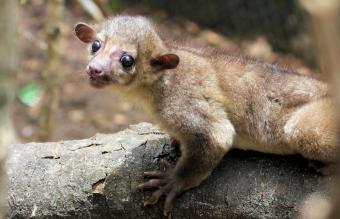
The kinkajou is a small mammal that belongs to the Procyonidae family. Learn interesting kinkajou facts and get to know this small mammal.
Kinkajou Facts
Fun facts about the kinkajou:
- Kinkajou nicknames include honey bear, nightwalkers, and la llorona (crying woman).
- Although they resemble primates, they belong to the Procyonidae family, which also includes racoons and ringtails.
- Kinkajous use their tail to balance while eating food and will also use their tails to keep warm at night.
- Kinkajous can be found in forests (tropical, dry, and evergreen).
- Kinkajous can weigh up to seven pounds.
- Kinkajous may live alone or in small groups.
- The kinkajou gestation period is about four months, and typically only one baby kinkajou is born.

What Is Unique About the Kinkajou?
Unique facts about the kinkajou:
- Kinkajous are arboreal, meaning they use trees to get around versus heading to the ground to travel.
- Kinkajous help pollinate flowers after drinking nectar.
- A kinkajou's tail ranges from 15 to 24 inches long.
- Their hind feet are webbed and are able to fully rotate.
- Their tongues are five inches long.
- Kinkajous can run as fast backwards as they can forwards.
- Kinkajous have incredible hearing and vision, which helps them see in the night (they're nocturnal), and escape predators they hear lurking nearby.
- Kinkajous are nursed for about eight weeks, and by a few months old can begin eating fruit and using their tail to navigate their environment to forage.
- Kinkajous mark their territory using scent glands which can be found on their face, chest, and throat.
What Does a Kinkajou Eat?
Kinkajous eat:
- Insects
- Nectar
- Eggs
- Honey
- Fruit
- Small hatchlings

How Do Kinkajous Protect Themselves?
Kinkajous can bite quite hard, are nimble when getting from tree to tree, and can run as fast backwards as they can forward to escape a predator.
Are Kinkajous Dangerous?
Kinkajous can be dangerous if they get startled. Although they may try to escape by running, or moving through the trees, they also use their claws and can bite very hard in order to injure their attacker.
Kinkajou Predators
Kinkajou predators include:
- Jaguars
- Ocelots
- Foxes
- Poachers
- Birds of prey
- Large snakes
Kinkajou Size
Kinkajous range in size from 16 to 50 inches in length. Their tails make up about half of their body length and are incredibly important to their survival.

Kinkajou Lifespan
Kinkajous can live up to 30 years in the wild, and can live up to 40 years in captivity. However, because they are nocturnal and spend most of their lives high up in the trees, it is difficult to know exactly how long they can live in the wild.
Kinkajou Interesting Facts
Kinkajous are fascinating little mammals that have a varied omnivorous diet and several means to escape predators. These adorable critters are certainly unique.







